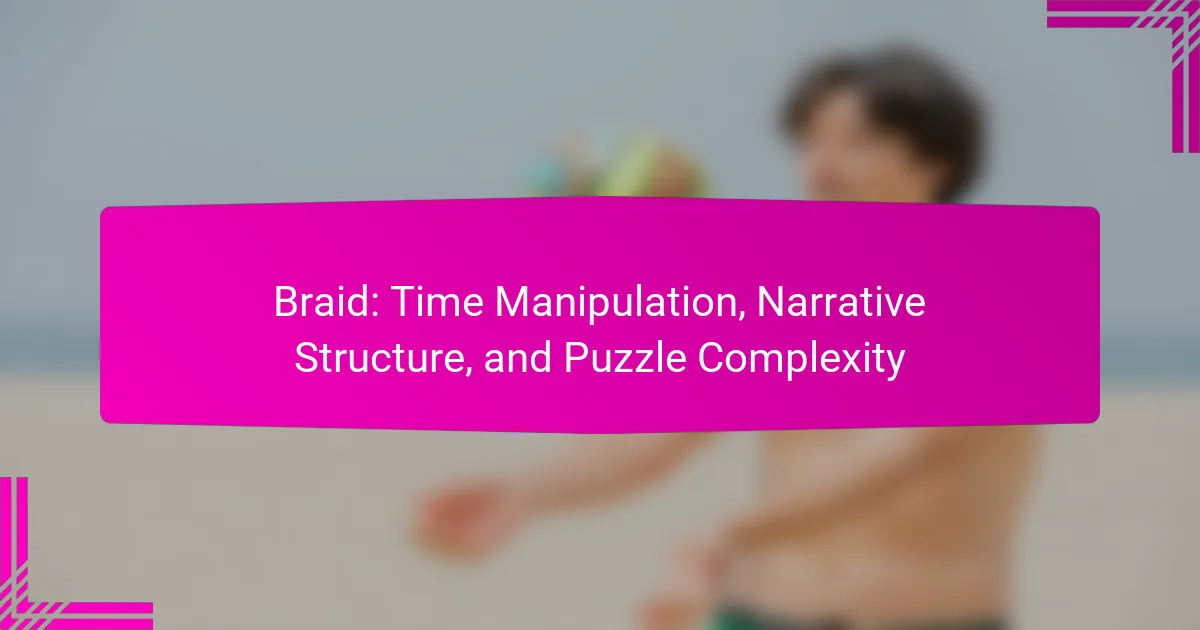Braid offers players a unique gameplay experience through time manipulation, enhancing puzzle complexity and narrative structure. The game allows players to rewind actions, adding strategic depth to puzzles. Its non-linear storytelling intertwines gameplay with themes of time and memory, creating a rich narrative experience. Additionally, the intricate puzzles challenge players to think critically and creatively, redefining traditional game design.

How does time manipulation enhance gameplay in Braid?
Time manipulation significantly enhances gameplay in Braid by allowing players to rewind actions, which adds layers of strategy and complexity to puzzles. This mechanic enables unique narrative experiences, as players can explore consequences and alternate outcomes. The interplay between time control and puzzle design creates a distinctive challenge that deepens player engagement. By manipulating time, players can solve intricate puzzles that would otherwise be impossible, showcasing the game’s innovative approach to gameplay mechanics.
What mechanics are involved in time control?
Braid employs mechanics of time control through nonlinear narrative, player-driven manipulation of time, and puzzle complexity. Players can rewind time to alter previous actions, affecting the game’s outcome. This mechanic deepens the narrative structure by intertwining player decisions with story progression. Unique attributes include the ability to solve puzzles by revisiting earlier moments, enhancing engagement and challenge. The integration of these mechanics creates a rich gameplay experience that emphasizes the connection between time and consequence.
How does time reversal affect puzzle-solving?
Time reversal enhances puzzle-solving by allowing players to manipulate time, creating complex strategies. In “Braid,” this mechanic deepens narrative engagement and puzzle complexity. Players can rewind actions, enabling exploration of multiple solutions and fostering critical thinking. This unique attribute transforms traditional puzzle dynamics, encouraging innovative problem-solving approaches.
Which levels showcase innovative time manipulation techniques?
“Braid” features innovative time manipulation techniques in its levels, particularly through the use of time reversal and parallel timelines. The game allows players to manipulate time to solve intricate puzzles, showcasing unique attributes like the ability to rewind actions and interact with past versions of the character. Levels such as “The First” and “The Second” exemplify these techniques, requiring players to think critically about the consequences of their actions across different time frames. This complexity enhances the narrative structure, making time a central element of both gameplay and story.

What role does narrative structure play in Braid’s storytelling?
Narrative structure in Braid plays a crucial role in enhancing the storytelling experience. It intertwines gameplay mechanics with the plot, creating a cohesive narrative that explores themes of time and memory. The non-linear progression allows players to piece together the story through puzzle-solving, thereby deepening engagement. Each level serves as a unique chapter, contributing to the overarching narrative while challenging players to reflect on their actions and choices. This innovative structure differentiates Braid from traditional platformers, making its storytelling more impactful and memorable.
How are themes of regret and redemption explored?
Themes of regret and redemption are central to Braid’s narrative, using time manipulation to explore consequences. The protagonist’s journey reveals how choices lead to remorse, while the mechanics of reversing time symbolize opportunities for redemption. Each puzzle reflects the complexity of decision-making, emphasizing that understanding past mistakes can lead to personal growth. The interplay of narrative structure and gameplay deepens the emotional experience, making the themes resonate with players.
Which storytelling techniques are unique to Braid?
Braid employs unique storytelling techniques, primarily through its innovative time manipulation and non-linear narrative structure. The game intertwines gameplay and story, allowing players to experience events out of sequence, enhancing emotional depth. Additionally, it utilizes puzzles that reflect the narrative themes, requiring players to engage with the story actively. This integration of mechanics and storytelling creates a distinctive experience that challenges traditional narrative forms in gaming.
How does the narrative intertwine with gameplay mechanics?
The narrative in Braid intricately connects with gameplay mechanics through time manipulation. Players solve puzzles that reflect the story’s themes, emphasizing cause and effect. As players rewind time, they experience narrative layers, revealing character motivations and plot twists. This synergy enhances engagement, making gameplay a narrative exploration. The unique attribute of Braid lies in its ability to intertwine storytelling with interactive challenges, creating a profound emotional impact.

What makes the puzzles in Braid uniquely challenging?
The puzzles in Braid are uniquely challenging due to their innovative time manipulation mechanics and intricate narrative structure. Each puzzle requires players to think non-linearly, as actions can be reversed or altered through time. This complexity is further enhanced by the game’s layered storytelling, which intertwines puzzle solutions with character development and themes of regret. Players must not only solve puzzles but also comprehend the narrative implications of their actions, creating a rich and multifaceted gameplay experience.
Which types of puzzles are featured throughout the game?
Braid features a variety of puzzles, primarily revolving around time manipulation. Key types include platforming challenges, logic puzzles, and spatial reasoning tasks. Each puzzle requires players to think critically about time’s impact on their actions and the environment. These elements combine to create a complex narrative structure that enhances the gameplay experience.
How does complexity vary across different levels?
Complexity in “Braid” varies significantly across its levels, influenced by time manipulation mechanics and narrative structure. Early levels introduce basic puzzle-solving concepts, while later levels integrate intricate time mechanics, demanding deeper strategic thinking. The narrative unfolds alongside gameplay, enhancing complexity as players progress. This layered approach creates a unique challenge, blending story and puzzle elements seamlessly.
What are common strategies players use to overcome difficult puzzles?
Players often use a variety of strategies to tackle challenging puzzles in Braid. Common methods include analyzing the mechanics of time manipulation, experimenting with different approaches, and utilizing narrative clues.
Understanding the unique attributes of each puzzle can reveal hidden solutions. For instance, players might manipulate time to observe the consequences of their actions before committing. Collaborating with others for fresh perspectives is also effective.
Additionally, players may take breaks to return with a clearer mindset. This approach helps in rethinking strategies and overcoming mental blocks. Ultimately, persistence and creative thinking are key to navigating Braid’s complex puzzle landscape.

How do cultural perceptions influence the interpretation of Braid’s themes?
Cultural perceptions significantly shape the interpretation of Braid’s themes, particularly regarding time manipulation and narrative structure. Different cultures may emphasize various aspects of time, influencing how players engage with the game’s mechanics. For instance, cultures with a linear view of time may struggle with the non-linear storytelling, while those with a cyclical perspective may find it more intuitive. Additionally, puzzle complexity can be perceived differently based on cultural familiarity with problem-solving approaches. This diversity in interpretation leads to a richer understanding of the game’s themes, as players bring their unique backgrounds into their gameplay experience.
Which themes resonate differently across various regions?
Themes related to “Braid: Time Manipulation, Narrative Structure, and Puzzle Complexity” resonate differently across regions due to cultural interpretations and gaming preferences.
In regions with a strong emphasis on narrative, players appreciate the intricate storytelling and character development. For example, in Japan, the focus on emotional depth enhances the game’s appeal. In contrast, regions that prioritize gameplay mechanics may find the puzzle complexity more engaging, valuing the challenge over the narrative.
Cultural symbolism also influences how time manipulation is perceived. In Western cultures, themes of control and consequence resonate strongly, while Eastern cultures may focus on the philosophical implications of time.
Overall, regional preferences shape the reception of Braid’s themes, highlighting the importance of cultural context in gaming experiences.
How do player experiences differ based on cultural context?
Player experiences in “Braid” vary significantly based on cultural context, influencing interpretation and engagement. Cultural backgrounds shape players’ understanding of time manipulation, narrative structure, and puzzle complexity. For example, players from cultures emphasizing linear storytelling may struggle with the game’s non-linear narrative. Conversely, those familiar with abstract problem-solving may appreciate the intricate puzzles more deeply. Additionally, cultural values impact the perceived significance of the game’s themes, such as regret and redemption, leading to diverse emotional responses. Overall, cultural context enriches the gameplay experience, creating a spectrum of interpretations and interactions with “Braid.”

What are the key takeaways from Braid’s design philosophy?
Braid’s design philosophy emphasizes innovative time manipulation, a layered narrative structure, and intricate puzzle complexity. The game uniquely integrates its mechanics with storytelling, enhancing player engagement. Time manipulation allows players to rewind actions, creating a rare gameplay experience. The narrative structure interweaves personal themes with gameplay, offering a unique emotional depth. Additionally, the puzzle complexity challenges players, requiring critical thinking and creativity to progress. These elements collectively redefine traditional game design and player interaction.
Which design elements contribute to player engagement?
Braid’s design elements like time manipulation, narrative structure, and puzzle complexity significantly enhance player engagement. Time manipulation creates unique gameplay dynamics, allowing players to experiment with strategies. The narrative structure weaves a compelling story that encourages emotional investment. Puzzle complexity challenges players, fostering satisfaction upon solving. Together, these elements create a rich, immersive experience that captivates players.
How can other games learn from Braid’s approach?
Braid’s approach offers valuable lessons for other games by emphasizing innovative gameplay mechanics, narrative depth, and engaging puzzles. Other developers can adopt time manipulation to enhance player interaction and create unique challenges. Integrating narrative structure that evolves with gameplay can deepen emotional engagement. Additionally, focusing on puzzle complexity encourages critical thinking, making the gaming experience more rewarding. These elements can differentiate games in a crowded market, attracting players seeking more than traditional mechanics.
What best practices should developers consider when designing narrative-driven puzzles?
Developers should prioritize player engagement, clarity, and narrative integration when designing narrative-driven puzzles. Effective puzzles enhance the story while challenging players without causing frustration.
1. Align puzzles with narrative themes to reinforce the story.
2. Ensure clarity in puzzle mechanics to avoid confusion.
3. Incorporate intuitive hints to guide players without breaking immersion.
4. Balance difficulty to maintain player interest and satisfaction.
5. Use time manipulation creatively, as seen in Braid, to deepen puzzle complexity.
